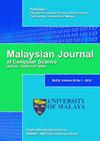MAPPING DEFORESTATION IN PERMANENT FOREST RESERVE OF PENINSULAR MALAYSIA WITH MULTI-TEMPORAL SAR IMAGERY AND U-NET BASED SEMANTIC SEGMENTATION
IF 1.2
4区 计算机科学
Q4 COMPUTER SCIENCE, ARTIFICIAL INTELLIGENCE
引用次数: 0
Abstract
Deforestation is the long-term or permanent conversion of forest land to other uses, such as agriculture, mining, and urban development. As a result, deforestation has catastrophic consequences for the environment, including the loss of biodiversity, disruption of clean water supplies, and the acceleration of climate change. According to statistics, the deforestation trend in developing countries is at an alarming rate including Malaysia where plantation activities are the primary cause of forest loss. Recent anecdotal studies have demonstrated the effectiveness of the deep learning-based (DL) approach in producing deforestation maps. However, there are limited studies concentrating on DL approach for synthetic aperture radar (SAR) imaging due to complexity of the computational concepts of the method. The SAR imagery can be challenging to interpret but its all-weather and all-day capability can be critical in forest monitoring compared to optical imagery. Thus, in this study, we propose to map deforestation areas in Permanent Forest Reserve (HSK) using multi-temporal Sentinel-1 SAR data. Deep learning-based U-Net was employed to classify the SAR imagery as forest and non-forest due to its semantic segmentation capabilities. The experiment results showed that the proposed deep learning-based technique successfully achieved 0.993 of intersection over union (IoU) and 0.980 of overall accuracy (OA). Also, we explained the entire procedure from beginning to end as simple as possible for beginners to comprehend. In brief, the findings of this study have the potential to improve monitoring of damaged HSK areas, prioritize the restoration of the affected forest areas and protecting the forest lands from illegal deforestation activities.基于多时间SAR图像和U-NET语义分割的马来西亚半岛永久性森林保护区森林砍伐地图绘制
森林砍伐是指将林地长期或永久地改为其他用途,如农业、采矿和城市发展。因此,森林砍伐对环境造成了灾难性后果,包括生物多样性的丧失、清洁水供应的中断以及气候变化的加速。据统计,发展中国家的森林砍伐趋势令人震惊,包括马来西亚,那里的种植活动是森林损失的主要原因。最近的轶事研究证明了基于深度学习的方法在绘制森林砍伐地图方面的有效性。然而,由于合成孔径雷达(SAR)成像的计算概念的复杂性,对DL方法的研究有限。SAR图像的解释可能很有挑战性,但与光学图像相比,其全天候和全天的能力在森林监测中至关重要。因此,在本研究中,我们建议使用多时相Sentinel-1 SAR数据绘制永久森林保护区(HSK)的森林砍伐面积图。基于深度学习的U-Net由于其语义分割能力,被用于将SAR图像分为森林和非森林。实验结果表明,所提出的基于深度学习的技术成功地实现了0.993的联合交集(IoU)和0.980的总体精度(OA)。此外,我们从头到尾尽可能简单地解释了整个过程,供初学者理解。简言之,这项研究的结果有可能改善对HSK受损地区的监测,优先恢复受影响的林区,并保护林地免受非法砍伐活动的影响。
本文章由计算机程序翻译,如有差异,请以英文原文为准。
求助全文
约1分钟内获得全文
求助全文
来源期刊

Malaysian Journal of Computer Science
COMPUTER SCIENCE, ARTIFICIAL INTELLIGENCE-COMPUTER SCIENCE, THEORY & METHODS
CiteScore
2.20
自引率
33.30%
发文量
35
审稿时长
7.5 months
期刊介绍:
The Malaysian Journal of Computer Science (ISSN 0127-9084) is published four times a year in January, April, July and October by the Faculty of Computer Science and Information Technology, University of Malaya, since 1985. Over the years, the journal has gained popularity and the number of paper submissions has increased steadily. The rigorous reviews from the referees have helped in ensuring that the high standard of the journal is maintained. The objectives are to promote exchange of information and knowledge in research work, new inventions/developments of Computer Science and on the use of Information Technology towards the structuring of an information-rich society and to assist the academic staff from local and foreign universities, business and industrial sectors, government departments and academic institutions on publishing research results and studies in Computer Science and Information Technology through a scholarly publication. The journal is being indexed and abstracted by Clarivate Analytics'' Web of Science and Elsevier''s Scopus
 求助内容:
求助内容: 应助结果提醒方式:
应助结果提醒方式:


